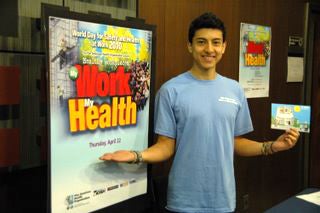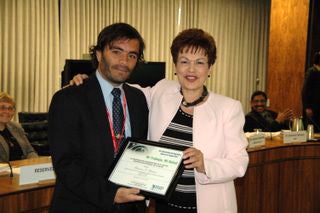
 In Latin America and the Caribbean, a worker is injured on the job every 36 minutes, and as many as 80 million workers suffer injuries or illness due to exposure to occupational risks every year, experts said today at a panel discussion on World Day for Safety and Health at Work, held at the Pan American Health Organization (PAHO) in Washington, D.C.
In Latin America and the Caribbean, a worker is injured on the job every 36 minutes, and as many as 80 million workers suffer injuries or illness due to exposure to occupational risks every year, experts said today at a panel discussion on World Day for Safety and Health at Work, held at the Pan American Health Organization (PAHO) in Washington, D.C.
Washington, D.C., April 22 2010 (PAHO) — In Latin America and the
Caribbean, a worker is injured on the job every 36 minutes, and as many
as 80 million workers suffer injuries or illness due to exposure to
occupational risks every year, experts said today at a panel discussion
on World Day for Safety and Health at Work, held at the Pan American
Health Organization (PAHO) in Washington, D.C.
Worldwide, some 1.9 billion workers—including 170 million children—are
employed in unhealthy or unsafe working conditions, producing an
estimated 160 million new cases of work-related illness each year,
according to estimates of the World Health Organization (WHO).
Occupational risks also contribute significantly to chronic diseases,
accounting for more than one-fourth of cardiovascular disease, 15
percent of asthma, and 10 percent of cancers. Studies show that the
economic costs of health-related losses in productivity are as much as
4-5 percent of GDP.


"Investing in the workplace makes sense not only from an ethical and
social perspective, but also from an economic perspective," said Dr.
Socorro Gross, Assistant Director of PAHO. "Studies clearly show
important benefits to investing in occupational safety and health."
The countries of Latin American and the Caribbean, with an estimated
270 million workers, have among the highest death rates due to
occupational accidents of any region, according to the International
Labor Organization (ILO). Only 10-15 percent of the region's workers
have access to any type of occupational health services.
"What we need is a small revolution," said Dr. Maria Neira, Director
of the Department of Public Health and the Environment at WHO. She
called for a comprehensive approach to improving workers' health, one
that minimizes safety risks while cultivating healthy and sustainable
lifestyles among workers and in the community. Such an approach can
reduce workplace deaths and injuries, cut healthcare costs, protect the
environment, and improve the quality of life for millions of working
people throughout the Americas and the world.
This comprehensive approach should include the following:
- Action to minimize workers' exposure to job-related risks, both physical and psychosocial
- Health promotion to encourage healthy behaviors both on and off the job. This includes smoking cessation and weight control programs, health testing and check-ups, and promotion of exercise and physical activity.
- Involvement in the community by workers and employers to address the broader social and environmental influences on workers' health, including safe transportation, pollution control and clean-up, and access to health services.
Workplace-based health programs have been shown to reduce the costs of
health services by over 25 percent and can increase productivity by
5-10 percent, with a total return on investment varying from 300
percent to 600 percent, said PAHO's Dr. Gross.
"On the other hand, ignoring safety and health at work has a negative
impact on the lives of workers, their families, and communities and
takes a significant toll on economic development," she added.
In the United States, the recent deaths of mine workers in West
Virginia and oil workers in Washington state and Louisiana "are just
the tip of the iceberg," said David Michaels, U.S. Assistant Secretary
of Labor for Occupational Safety and Health. An average of 14 workers
are killed on the job every day, while thousands more suffer injuries,
and many thousands are exposed to toxic substances, Michaels said.
Latino workers are at particularly high risk, with an estimated 14
killed each week on the job. "There's a parallel universe of
workers—some documented, some not—who are exposed to very dangerous
conditions as well as to wage theft and other kinds of exploitation,"
said Michaels.
To address the problem, the U.S. Occupational Safety and Health
Administration (OSHA) is partnering with Mexico and its consulates in
the United States to provide immigrant workers as well as employers
with information, guidance, and access to training resources to improve
working conditions and to help them understand their rights and
responsibilities under the Occupational Safety and Health Act. OSHA is
also providing technical cooperation on worker safety in a number of
Latin American and Caribbean countries, including Bahamas, Barbados,
Colombia, Panama, and Trinidad and Tobago.
For its part, PAHO has been working with partners in the public and
private sectors in its Member States to develop and implement a
comprehensive "Healthy Workplaces" framework for policy and action that
focuses on both the physical and the psychosocial environment at work
and emphasizes the roles of employers, workers, and public health
specialists in creating safe and healthy workplaces.
"Considering that we spend two-thirds of our lives at work, the
workplace is being used more and more as a platform for health
promotion and prevention," said Dr. Gross.
PAHO was established in 1902 and is the world's oldest public health
organization. It works with all the countries of the Americas to
improve the health and quality of life of the people of the Americas
and serves as the Regional Office for the Americas of the World Health
Organization (WHO).
CONTACT: Donna Eberwine-Villagran, email: eberwind@paho.org, tel. +1 202 974 3122, Knowledge Management and Communication Area, PAHO/WHO — http://www.paho.org/



